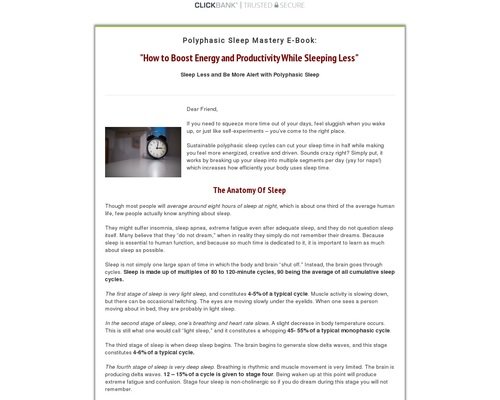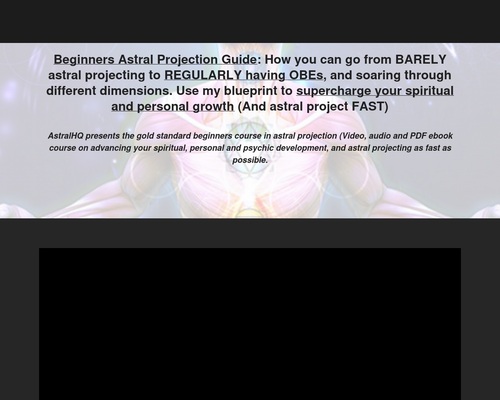
Product Name: Polyphasic Sleep Mastery – Polyphasic Society
[ad_1]
All orders are protected by SSL encryption – the highest industry standard for online security from trusted vendors.

Polyphasic Sleep Mastery – Polyphasic Society is backed with a 60 Day No Questions Asked Money Back Guarantee. If within the first 60 days of receipt you are not satisfied with Wake Up Lean™, you can request a refund by sending an email to the address given inside the product and we will immediately refund your entire purchase price, with no questions asked.
Description:
Sleep Less and Be More Alert with Polyphasic Sleep
If you need to squeeze more time out of your days, feel sluggish when you wake up, or just like self-experiments – you’ve come to the right place.
Sustainable polyphasic sleep cycles can cut your sleep time in half while making you feel more energized, creative and driven. Sounds crazy right? Simply put, it works by breaking up your sleep into multiple segments per day (yay for naps!) which increases how efficiently your body uses sleep time.
Though most people will average around eight hours of sleep at night, which is about one third of the average human life, few people actually know anything about sleep.
They might suffer insomnia, sleep apnea, extreme fatigue even after adequate sleep, and they do not question sleep itself. Many believe that they “do not dream,” when in reality they simply do not remember their dreams. Because sleep is essential to human function, and because so much time is dedicated to it, it is important to learn as much about sleep as possible.
Sleep is not simply one large span of time in which the body and brain “shut off.” Instead, the brain goes through cycles. Sleep is made up of multiples of 80 to 120-minute cycles, 90 being the average of all cumulative sleep cycles.
The first stage of sleep is very light sleep, and constitutes 4-5% of a typical cycle. Muscle activity is slowing down, but there can be occasional twitching. The eyes are moving slowly under the eyelids. When one sees a person moving about in bed, they are probably in light sleep.
In the second stage of sleep, one’s breathing and heart rate slows. A slight decrease in body temperature occurs. This is still what one would call “light sleep,” and it constitutes a whopping 45- 55% of a typical monophasic cycle.
The third stage of sleep is when deep sleep begins. The brain begins to generate slow delta waves, and this stage constitutes 4-6% of a typical cycle.
The fourth stage of sleep is very deep sleep. Breathing is rhythmic and muscle movement is very limited. The brain is producing delta waves. 12 – 15% of a cycle is given to stage four. Being waken up at this point will produce extreme fatigue and confusion. Stage four sleep is non-cholinergic so if you do dream during this stage you will not remember.
The fifth and final stage of sleep is REM sleep, which is an acronym for rapid eye movement. Brainwaves speed up and dreaming occurs. If a person is completely still while sleeping, has shallow breathing, and is rapidly moving their eyes under their eyelids, they are in REM sleep.
Here is a graph portraying one’s passage through different cycles in a monophasic sleep cycle. A person will get most of their deep sleep in the first three hours, and most of their REM in the last three.
Monophasic sleep can be healthy like this child’s, but even this child wakes up expecting polyphasic sleep.
As we get older, it only gets worse trying to force a monophasic sleep. Sleep continuity and quality both continually degrade, like this Adult:
Historically human beings naturally slept in two distinct phases, with a period of wakefulness separating the two phases. There is evidence from sleep research, as well as from the reports of individuals, that this bi-modal sleep pattern, combined with a midday nap results in the experience of greater wakefulness during the day time, than uninterrupted sleep. During that period of wakefulness, the brain secretes high levels of prolactin, a hormone associated with a feeling of calm and well-being.
Historically this time of wakefulness between the two sleep segments was considered a special and even sacred time. Laborers tired from working the fields would have the energy to have sexual relations after their first period of sleep, people engaged in spiritual practices such as prayer, reflection and meditation, and others used the quiet time to read and write. Dreams were more available to be remembered during that time than upon awakening in the morning.
The historian Robert Ekirch summarized in his book At Day’s Close: Night in Times Past, the abundant historical evidence that humans previously slept in two separated segments. This custom was common knowledge and there are many references to it.
He unearthed more than 500 references to a segmented sleeping pattern – in diaries, court records, medical books and literature, from Homer’s Odyssey to an anthropological account of modern tribes in Nigeria.
During this waking period people were quite active. They often got up, went to the toilet or smoked tobacco and some even visited neighbors. Most people stayed in bed, read, wrote and often prayed. Countless prayer manuals from the late 15th Century offered special prayers for the hours in between sleeps.
And these hours weren’t entirely solitary – people often chatted to bed-fellows or had sex.
By the 1920s the idea of a first and second sleep had receded entirely from our social consciousness.
He attributes the initial shift to improvements in street lighting, domestic lighting and a surge in coffee houses – which were sometimes open all night. As the night became a place for legitimate activity and as that activity increased, the length of time people could dedicate to rest dwindled. “Many people wake up at night and panic, I tell them that what they are experiencing is a throwback to the bi-modal sleep pattern.” – Russel Foster
Polyphasic sleep has been connected to better heat control and better survival in freezing cold conditions. Naturally, when we sleep our body temperature drops, and being asleep for more than a short while could leave us susceptible to damage from cold, hypothermia, and death. Humans obviously had to experience survival in the ice ages and so along with such adaptations as brown adipose tissue and ketosis to keep warm, we may have also begun polyphasic sleep as a cold-survival mechanism.
By sleeping monophasically, we may even be fighting nature itself. Some studies indicate that sleeping in multiple blocks may be imprinted in our genetic code after millennia of evolution.
“We presumably evolved to sleep at night and then take a relatively short nap at some point during the day if possible,” says Dr. James Gangwisch, assistant professor of Psychology at the Columbia University College of Physicians and Surgeons and a research scientist at the New York State Psychiatric Institute. Gangwisch’s research focuses on the relationship between sleep duration, psychiatric disorders and metabolic syndrome-associated diseases.
Those monophasic sleepers who stayed still for eight hours straight risked being devoured by some roaming predator. Reports of polyphasic sleep schedules in hunter-gatherer tribes in South America, Southeast Asia, and Africa indicate that in less technologized societies, this reality is still the case.
Quite a few successful historical figures were purportedly polyphasic sleepers. Such luminaries as Thomas Edison, Benjamin Franklin, Nikola Tesla, Napoleon, Winston Churchill, Thomas Jefferson and Leonardo DaVinci reportedly followed the fragmented schedule. Their achievements perpetuate the notion that there is a link between genius and efficient sleep.
The idea gained popularity in the 1970’s and 80’s among the scientific community. Buckminster Fuller, a famous American inventor, architect, and philosopher of the 1900’s, championed this kind of slumber. He branded his version Dymaxion sleep. Here, you take a half hour nap every six hours and sleep a total of just two hours per night. Swiss artist Francesco Jost practiced it for 49 days straight once, while observed by Italian neurologist Claudio Stampi.
BONUS #1 – The Quiet Mind E-Book – Discover How To Incorporate Meditation Into Your Life And Start Seeing Your Life Change In Mere Minutes Per Day
BONUS #2 – Easy Productivity Secrets E-Book – Are you one of the millions of people wishing they could get just a few more hours in the day? Discover The Secrets Of Boosting Your Productivity and Getting More Done In Less Time So That You Can Enjoy More of Life!
BONUS #3 – Simplify And De-stress E-Book – Changing your habits to cut the stress and be happier.
BONUS #4 – Beginners Guide to Lucid Dreaming E-Book – Which would you choose? To Fly? To Be an Eagle and Fly? To Walk Through Walls? To Have Superhuman Strength? All these things and more are possible in your dreams with Lucid Dreaming!
Now you can test drive our product for two months with NO RISK!
If you think that our product is useless for you, simply contact our support, and will return 100% of your money. No Question Asked!
So if you’re ready for a new life where you’re excited to go to sleep at night, and you spend each day feeling well-rested and refreshed…
Then click the button below to add the Polyphasic Sleep Mastery to your cart right now.
Copyright © 2018. The Polyphasic Society | Disclaimer | Privacy Policy | Affiliates | Contact Us
This is the bottom slider area. You can edit this text and also insert any element here. This is a good place if you want to put an opt-in form or a scarcity countdown.
[ad_2]
All orders are protected by SSL encryption – the highest industry standard for online security from trusted vendors.

Polyphasic Sleep Mastery – Polyphasic Society is backed with a 60 Day No Questions Asked Money Back Guarantee. If within the first 60 days of receipt you are not satisfied with Wake Up Lean™, you can request a refund by sending an email to the address given inside the product and we will immediately refund your entire purchase price, with no questions asked.







